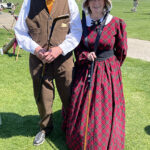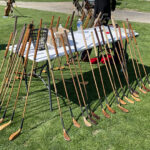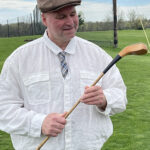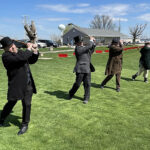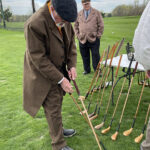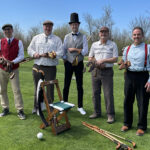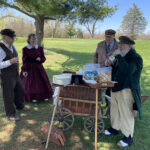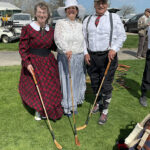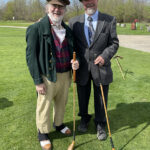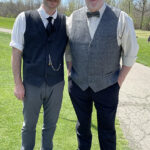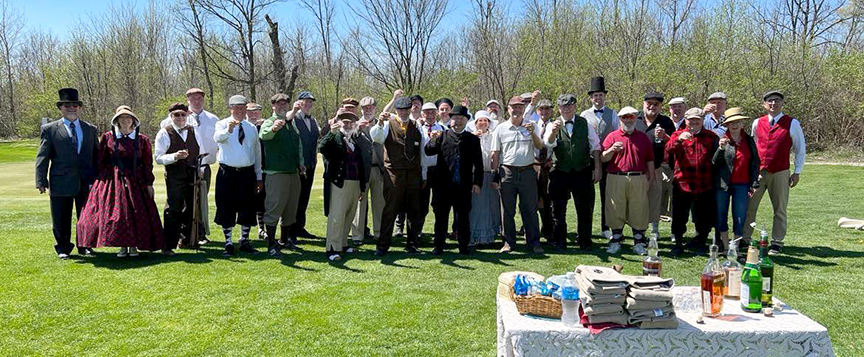
The players at the 2023 Oddball Hickory Classic, a feather ball golf outing.
By Jim Davis
There were no caddies with this group. The sternly dressed men in black coats wore an odd mix of bowlers, top hats and tradesmen caps. Under their arms they each carried from four to eight clubs of a peculiar, though somehow graceful, look – long, slender and narrow, a few with noticeably curved faces. A few clubs were backed with a lead filling and some had horn applied to the sole on the leading edges.
On the teeing area they stopped to survey the scene. The group ahead being judged safely away, one scooped some sand from a nearby source and built a roughly conical mound on which he placed a ball – a rough ball of leather, scuffed and smeared with grass stains. A waggle or two and he swung the club in a long, looping circle behind his back and then through the ball which, with a sort of “thwap” soared some 80 yards away. Might have been closer to 90. The other three members of the foursome nodded, murmuring in approval.
This particular golfer, looking especially dapper, or like a hobo fresh from the tracks having pilfered from several clotheslines or thrift shops, was pleased. He looked lovingly at his club, a close facsimile of an 1840s-era Wilson play club with a 15-degree loft. Yes, he seemed to be thinking, this will do nicely.
The scene was not on the Musselburgh Old course in 1845, but on Friday, April 14, 2023 at the Hillcrest Golf Center in Washington, Ill.; perhaps, the only place on the planet where long-nosed clubs and feather balls were in play at that particular moment. Some 30 men and women had come from around the American Midwest at the invitation of Denny and Cathy Lane, feather ball makers and hosts of what they are pleased to call “The Oddball Tournament.”
Denny is retired from UPS and works part-time for Hillcrest on the maintenance crew, and Cathy is a retired camp director for the local parks department. Their combined interest in golf history and crafts led them, about eight years ago, to explore making feather golf balls. Denny estimates that, after many early failures and experiments, the couple has now produced some 600 featheries.
Such is their enjoyment of golf history and in making their featheries, that it seemed only natural to share the experience of playing this early style of golf. So, for the past five years they have hosted a feathery and gutty ball tournament at Hillcrest. Gutty, of course, refers to gutta percha, the ball that began to replace the feathery around 1848 and which became a key development in the great surge in golf’s popularity in Great Britain.
Over the past 20 years as hickory golf has grown in global popularity the couple’s tournament has come to attract a like-minded set of golfing pilgrims who wish to experience what all the fuss was about back in 1840 when red-coated gentlemen could be seen gadding about over the sandy, hummocky land near the coast of several Scottish towns in pursuit of their mad and foolish game.
The modest track of the Hillcrest Golf Center of East Peoria would, by any measure, serve as a poor example of sandy linksland, but you have to find your feather ball makers where you can. This year, the Oddball also welcomed two serious makers of long-nosed clubs to display their wares and talk about their craft.
Original long-nosed clubs from the late feather ball era (1830-50) made by such legendary makers as Hugh Philp, the McEwan family, the Cossars, and James Wilson, now fetch many thousands of dollars at auction. Their time had been thought long past, examples of such clubs found only in museums and the shelves of private collectors, curious relics of a rude game no serious modern golfer would consider, let alone be aware of.
There is an elegance about those old long-nosed clubs, with slender heads that seem to pour as liquid wood from the shaft, captured in graceful curves and proportions. There is an as-yet faint song of romance about them, which has found resonance with a new breed of clubmakers, woodworkers with a desire to emulate the craft of those long-ago artisans. How did they do it? How were those clubs made? Several craftsmen have tried their hand over the years. Replica long-nosed clubs have surfaced here and there, usually considered as no more than curiosities of a woodworker’s fancy. And, of course, there have been clever forgeries, too, attempts to part the unlearned eye from its owner’s cash.
Elmer Nahum of Sewickley, Pa., and Kelly Leonard of Manitoba, Canada, are two of the leading craftsmen who have brought the ancient art out of the history books and onto the current page of golfing heritage. Their clubs, rather than fakes or forgeries intended only to deceive, are the original result of modern and painstaking craftsmanship, clearly an attempt to follow in their historic predecessors’ footsteps, but with their own stamp of authenticity, direct descendants of the long ago artisans.
As Philp and others made clubs for the golfers of their day, so do Nahum and Leonard create long-nosed clubs for the 21st century golfer who wishes to understand and appreciate the nature of the feathery game, at the very least to approximate what that experience might have been.
Nahum, a slender man with a scholarly appearance, is a retired radiologist who is widely known for his book Practical Clubmaking, a guide to the making of long-nosed era clubs. It is a meticulous dive into the methodology and the tools he employs in the design and creation of the elegant clubs. Each is a loving testimony to the early craftsmanship. Nahum does not offer clubs for sale, but makes them for his own enjoyment, the pleasure in giving some as gifts, or in seeing another use them during a round.
For Leonard, a burly Canadian with big hands and an affable demeanor, the 14-hour drive from Manitoba was rewarded with an opportunity to showcase his clubs firsthand to a truly appreciative choir of pre-1900 hickory golf aficionados. At some $320 a pop, give or take a few dollars, these are not a casual purchase. Each represents hours of woodworking, finishing, gripping and whipping (thread windings about the hosel and the grip) before it is considered ready for play – or display as you will, for you are buying a bit of playable art.
Arranged along a table, dozens of beautiful clubs were displayed in dark and light finishes, from putters to play clubs, long and short spoons, perhaps even a mid spoon or two, each based on painstaking measurements of clubs by early club makers. Nahum and Leonard – particularly Leonard, as he was selling clubs – were peppered with questions on matters of weight, loft, length and so forth; the arcane substance of equipment that have concerned golfers since the days of Philp and Old Tom.
Potential buyers were allowed to walk a few steps away and test a club on a makeshift driving range with either feathery or gutta percha golf balls. A featherball driving range! Has this ever happened before? Does anyone know of such a thing? Surely this is a first in the history of the long game.
Also at the Oddball were two or three woodworkers who had tried their hands at making long-nosed clubs, none as prolific as Nahum or Leonard, but all equally passionate about the process. Clubmakers of those early days surely got together now and again, but this is 2023 and these are the only people, to our knowledge, making such clubs in such abundance and with such care and joy in the process.
As for the ensuing round of feathery golf, Denny Lane had set up the Hillcrest course to measure just over 4,000 yards, closely following several holes on the back nine. The longest was perhaps 140 yards, the shortest about 80. Tees were marked by tin pails filled with wet sand for the molding of sand tees.
The “greens” were adjacent to Hillcrest’s regular greens and were small areas of somewhat closely mown grass, barely shorter than the fairways. Putting was an exercise in judicious puzzlement, with balls rather rumbling along, setting off at a fast pace only to stop suddenly as a dog that had lost the scent of its pursuit or the desire to continue. There were reports of putts that took 90-degree turns or that hopped into and out of the shallow cups. You couldn’t help but marvel at the unruly nature of the thing. Did the players of the 1840s have a like experience?
(For those who keep score, Tom Kerckhove won the matchplay contest on the feathery day. Joey Piatek was the top player on the gutty ball day. The matchplay contests are improvised scoring against “bogey” scores posted by a much maligned mascot known as Francis the Squirrel.)
Legion are those whose golfing experiences are as uniformly similar as the clubs they buy. Fewer are those today who may start a 19th hole conversation about a great shot they had with their 17-degree long spoon McEwan facsimile using a LANE feathery or a Park gutty ball made by McIntyre Golf. Fortunately, that style of golf is not for everyone. We may be forgiven our jealous enjoyment in this odd pastime.
Several Oddball players brought a mid-19th century flavor to the day with costumes that ranged from coats and tails to top hats, bowlers and tradesmen caps; the two or three ladies in the company chose long gowns and bonnets.
Mike Kinney, a sculptor, made his own outfit – a green tailed coat, canvas pants, and tradesman cap. He reminded me, somehow, of Allan Robertson. Others found their clothes in thrift shops or from online purveyors of historical garments. Joey Piatek of Indiana and Mike Brown of Wisconsin sported top hats, and Tom Kerckhove of Illinois could have come directly from his London law office, he in a handsome dark outfit set off with a bowler. Coats, ties, and neckerchiefs were the order of the day.
It was a colorful and cheerful crew, with no expectation of golfing glory other than the experience of a most unusual day in the company of good friends.
The Lanes prepared a pre-round toast to the spirit of the day and placed a ginger beer cart near the third green where one could enjoy another toast, a bit of a snack, or a Bundaberg ginger beer.
The sun shone, long-nosed clubs struck feather balls, occasionally well, and laughter was heard, more than occasionally.
Old Daw would most certainly have approved.
(Click on any photo in the gallery to bring up large photos that can be scrolled to view the others.)
- Denny and Cathy Lane, feather ball makers and hosts of the annual Oddball Hickory Classic.
- A selection of Kelly Leonard long-nosed clubs.
- Good job on this one. Kelly Leonard examines one of his creations.
- An historic first? From left, Tom Kerckhove, Mike Brown, Denny Lane, and Mike Kinney test long-nosed clubs with feather balls on a makeshift driving range.
- Which one? Denny Lane compares clubs with an eye to a purchase while Scott Petersen looks on.
- Modern day long-nosed club makers carry on a once lost art form. From left: Elmer Nahum, Kelly Leonard, Joey Piatek, Denny Olson, and Brad Korando.
- The ginger beer cart. From left: Joe Trefilek, Cathy Lane, Scott Petersen and Mike Kinney.
- Cathy Lane, left, and Carol and Ken Ferino all dressed for feathery golf.
- Mike Kinney, left, and Mike Brown with modern takes on early dress styles.
- Christian Williams, left, is a videographer of hickory golf. Andy Grow is a hickory golf connoisseur, traveler and writer.

